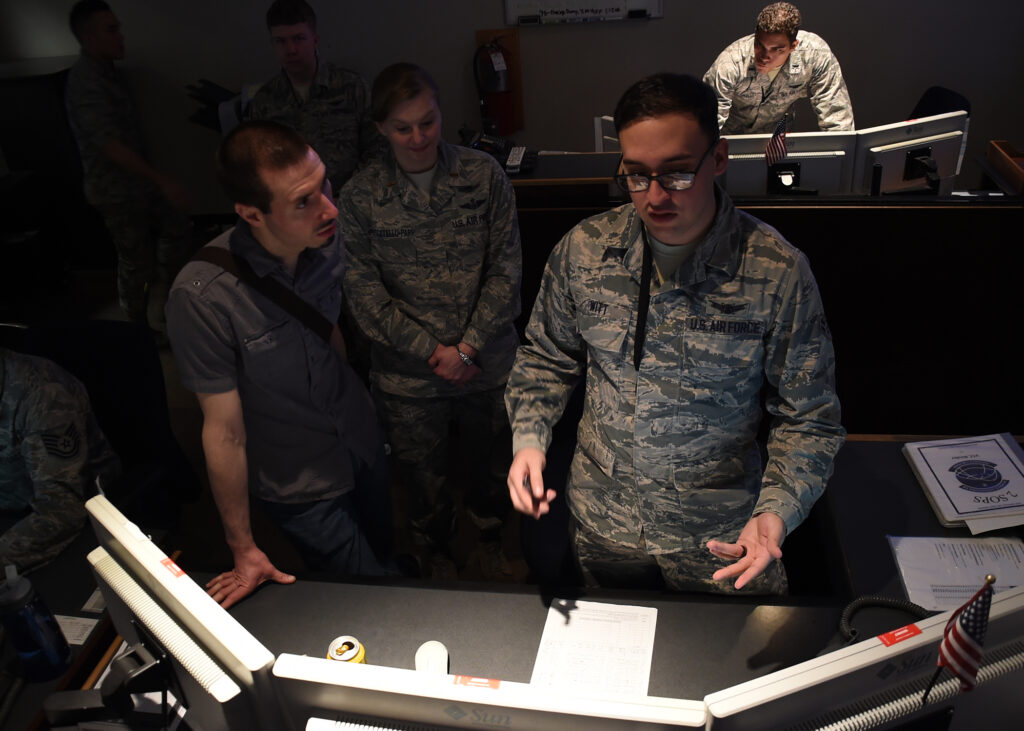
2nd Space Operations Squadron Operates GPS Satellites At Schriever AFB
SCHRIEVER AIR FORCE BASE: Defense Secretary Ash Carter, who spent five years pushing the National Reconnaissance Office and the military to work more closely together, saw the effects today during a tour of the JICSPOC, the experimental effort to improve battle management of America’s satellites.
Inside the heavily guarded secure facility where most of America’s satellites are flown and operated here, Carter got a briefing about the Joint Interagency Combined Space Operations Center. He met with NRO Director Betty Sapp, Strategic Command’s leader, Adm. Cecil Haney, and the head of Air Force Space Command, Gen. John Hyten. Sapp had resisted efforts to work with the military until Carter pressed his case hard last year. Haney is the combatant commander for space, and Haney’s command trains, operates and equips the vast majority of the military’s space warriors. None of them were made available to reporters (though Gen. Hyten did say hello), but their presence during Carter’s visit here spoke volumes, and he made a point of mentioning their presence to the press.
The goal of the JICSPOC is for the military and Intelligence Community (IC) to craft concepts of operation and clarify who does what and how in the event of attacks on US satellites. Although few people are actually assigned to the JICSPOC, the IC, Strategic Command and the Air Force bring together several hundred people to run the war games — which is what they really are — and then to figure out what the lessons are and they can improve their performance and implement the lessons learned.
Reporters accompanying Carter were not allowed to even see the door to the highly classified facility, but Carter told us the facility demonstrates how things are beginning to change. The Intelligence Community and the military were working “in one room, on one floor,” Carter told me when I asked if he thought changes to who commands America’s satellite in time of war would be needed.
He said the two groups can no longer work alone. “I work extremely well with Jimmy Clapper, the Director of National Intelligence. We can’t live in a world any more, and we don’t live in a world, where you can work on your own.”
He offered a physical manifestation of the changes underway. “Where there, once upon a time, had been a separate intelligence room, the door had been taken off. That’s the way it has to be.” So while the NRO and the IC may maintain separate legal and command authorities in the interim, the goal is for the two to be so closely bound together operationally that they do not stand alone. Overall, the Defense Secretary said he “was extremely pleased with the progress I saw there.”
Reporters also got rare access to the 2nd Space Operations Squadron, the people who bring you and their military colleagues the GPS signal every day. The most astonishing thing to this grizzled reporter was the fact that the young men and women flying and operating the 39 satellites still in orbit are, well, so young. The average age of the satellite system operators is 18 to 24 years of age. The lieutenant responsible for all GPS operations was an ancient 28. Some of the satellites they operate are older than they are.
Those young men and women watch large and aging computer screens to monitor the status of the satellites, trying to tell if they are being deliberately jammed, suffering from space weather or are under physical attack. One of the airmen told us each satellite has its quirks and foibles and they all get to know them. Some have a solar panel that’s stuck or a battery that’s draining faster than normal. The young crew members of 2 SOPS keep them running and emitting their incredibly accurate and increasingly powerful positioning and timing signals.
Air Force picks Anduril, General Atomics for next round of CCA work
The two vendors emerged successful from an original pool of five and are expected to carry their drone designs through a prototyping phase that will build and test aircraft.


























